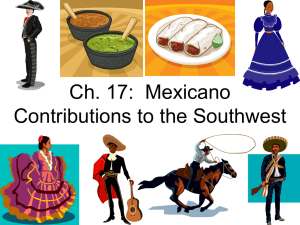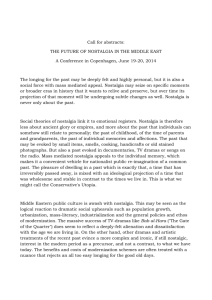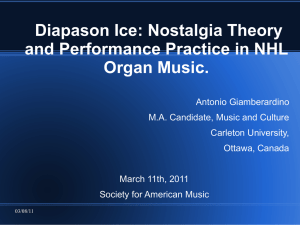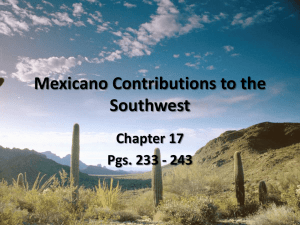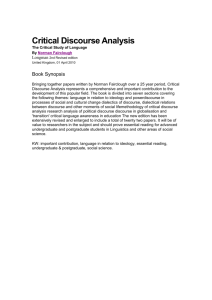this PDF file
advertisement
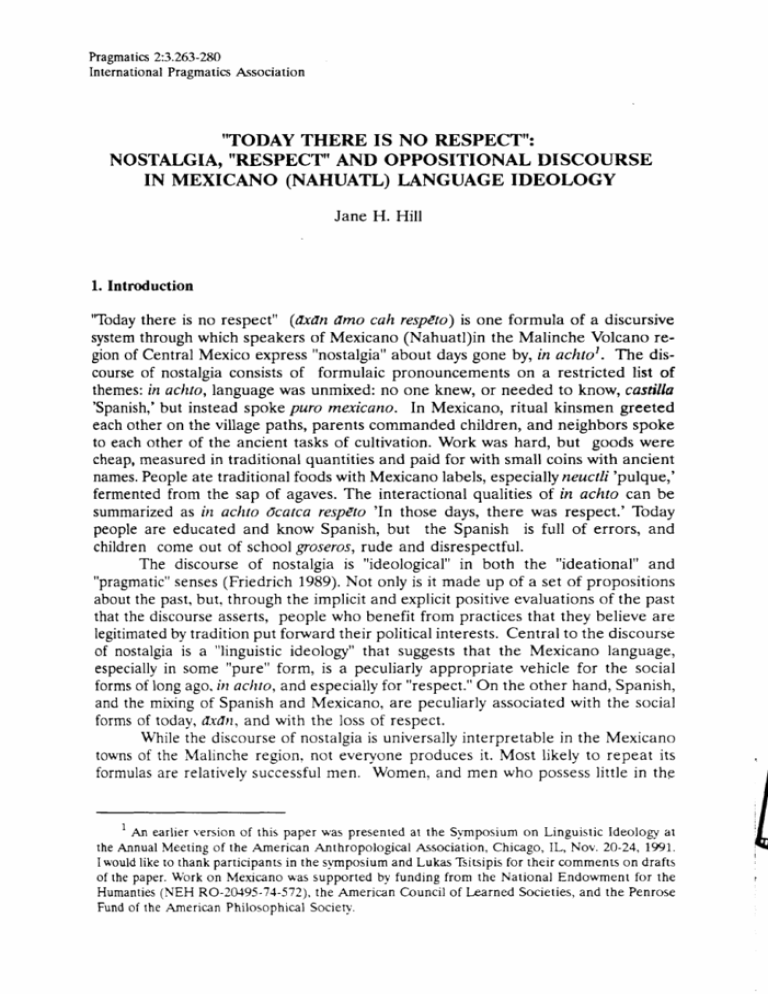
Pragmat ics 2:3.263-28O
InternationalPragmatics
Association
''TODAY THERE IS NO RESPECT'':
NOSTALGIA,"RESPECT"AND OPPOSITIONAL DISCOURSE
IN MEXICANO (NAHUATL) LANGUAGE IDEOLOGY
Jane H. Hill
1. Introduction
"Todaythere is no respect" (dxdn dmo cah resp€to)is one formula of a discursive
systemthroughwhich speakersof Mexicano(Nahuatl)in the Malinche Volcano regionof CentralMexico express"nostalgia"about daysgone by, in achtol. The discourseof nostalgiaconsistsof formulaic pronouncementson a restricted list of
themes:in achto,languagewas unmixed:no one knew, or neededto know,castilla
'Spanish,'but
insteadspokepuro mexicano. In Mexicano,ritual kinsmen greeted
eachother on the villagepaths,parentscommandedchildren,and neighborsspoke
to eachother of the ancient tasksof cultivation.Work was hard, but goods were
cheap,measuredin traditionalquantitiesand paid for with small coinswith ancient
names.Peopleate traditionalfoodswith Mexicanolabels,especiallyneuctli'pulque,'
fermentedfrom the sap of agaves.The interactionalqualities of in achto can be
summarizedas in achto 1catca respeb 'In those days, there was respect.' Today
peopleare educatedand know Spanish,but the Spanish is full of errors, and
children come out of schoolgroseros,rude and disrespectful.
The discourseof nostalgiais "ideological"in both the "ideational"and
"pragmatic"
senses(Friedrich1989).Not only is it made up of a set of propositions
aboutthe past,but. throughthe implicit and explicitpositiveevaluationsof the past
that the discourseasserts,people who benefit from practicesthat they believe are
Centralto the discourse
legitimated
by traditionput forwardtheir politicalinterests.
of nostalgiais a "linguisticideology" that suggeststhat the Mexicano language,
especially
in some "pure" form, is a peculiarlyappropriatevehicle for the social
formsof longago.irr achto,,
and especrally
for "respect."On the other hand,Spanish,
with the social
andthe mixingof Spanishand Mexicano,are peculiarlyassociated
formsof today,dxdtt,and with the loss of respect.
Whilethe discourseof nostalgiais universallyinterpretablein the Mexicano
townsof the Malincheregion.not everyoneproducesit. Most likely to repeat its
formulasare relativelysuccessful
men. Women,and men who possesslittle in thp
'
An earlier version of this paper was presentedat the S;"mposiumon Linguistic ldeology at
the Annual Meeting of the American Anthropological Association, Chicago, IL, Nov. 20-24, 1991.
I would like to thank participantsin the svmposiumand Lukas Tbitsipisfor their comments on drafts
of the paper.Wbrk on Mexicano \\'assupported by funding from the National Endowment for the
Humanties(NEH RO-2U95-'14-5'72),the American Council of lrarned Societies,and the Penrose
Fund of the American Philosophical Sociery.
264
JaneH. Hitt
way of the locally-relevantfrrrms of capital, seldom engage in the discourse.
Instead,they may produce an oppositionaldiscourse,contestingthe discourseof
nostalgia by exposing its formulas to contradiction and even to parody. This
"counter-discourse"
underminesthe termsof the linguisticideology,constitutingan
"interruption" (Silverman and Torode 1980) of the idea that particular trlrms of
languageare inextricablylinked to particular forms of social order. Further, this
interruption is more radical than are somewell-knownchallengesto languageform
and use in English. This may be becauseMexicano linguisticideologylocatesthe
crucial nexus of representationbetween dialogic action and social order, not
betweenreferenceand realitv.z
J
2. Nostalgia as a discursivesystem
Before turning to the counter-discourse,
I characterizewith greater precisionthe
content and organizationof the discourseof nostalgia.Its characteristicfilrmulas
developa smallset of major rhetoricalthemes: 1) "respect":the proper <lbseryance
of statusrelationships,especiallyillustratedby greetingsbetweencompadre.r'ritual
kin,' and commandsfrom parentsto reponsivechildren,contrastedwith t<tday's
groserta'rudeness',2) the sacrednature of the Mexicanocommunityand the ties
between its people, contrasted with contractual ties for profit, 3) a favrlrable
economy,in which goodswere cheap and life was rig<lnlusbut healthy,contrasted
with today's high prices and unhealthy ways; 4) cultivati<lnas the prototypical
human way of life, contrastedwith factorywork and schooling,seen as educational
preparationfor suchwork; 5) the useof Mexicanolong ago,vs. the useof Spanish
today; 6) the linguisticpurity of in achto,contrastedwith the languagemixing of
dxdn.3
These themes and their associatedf<lrmulasoccurred in sociolinguistic
interviewsconductedwith 96 speakersof Mexicanoin I I towns in the Malinche
Vo l canor egionbet w e e n7 9 7 4 a n d1 9 8 1 .N o s p e a kerusedal l of thesethemes,nrl r
did any speakerconnectthem in a coherentargument,either in the intcrviewrlr in
'
The distribution of the discourseof n<lstalgiaand its uluntcrdistx)ursc across groups in thc
Mexicano socio-scapeis not absolutc. Rrr instancc, Don Gabricl, whilc praising thc rigtr ol' oldcn
days, observes that his anc.estorswcre "enslaved',as indood thcy wcre (thcy wcrc bondcd laborcrs
o n a h a c i e n d a ) .O n t h e o t h e r h a n d , w o m c n w h i l e p r a i s i n g t h c o p p o r t u n i t i c s a v a i l a b l c t r i l a y , m a y
speak negatively of the rudenessr>fchildrcn rlr thc dangcr of crimc in thc citics.
3
Empirically, we can determine thar thc gcncral pattcrns ol borrowing lrom Spanish into
Mexicano, which permits loan vocabulary from cvcry grammatical catcgory of Spanish, wcrc wcllestablishedby the beginning of the lftth Ccntury (Karttuncn and l-rrckhart 19761.Thus not cvcn rhc
greal-greal-grandparentsof lhe oldest gcneration of u)ntcmporary Mcxicano spcakcrs livc<l in a
world in which there were no Spanishloans in Mcxicano. Notc that nostalgicdisrxrurscsarc rocordcd
f r o m a v e r y e a r l y p e r i o d i n M e x i c a n o c o m m u n i t i c s ;K a r t t u n c n a n d l , r r c k h a r t( 1 9 8 7 5n o t c a d i s q r u r s c
about a "golden age" in the Bancroft dialogucs, rc<xrrdodin ab<lut 157()-1511fi.
Thcir "Goltlcn Agc"
discourse reflects cln a time before the Cirnquest,whcn childrcn wcrc rigorously trainod and sin was
swiftly and sternly punished.
A m i n o r p o i n t o n M e x i c a n o o r t h o g r a p h y :t h c s y m b o lx s t a n d sl i r r I S J ,n o t I x J ,a s i s c x r n v c n t i o n ailn
o r t h o g r a p h i e so f t h e i n d i g e n o u sl a n g u a g c so f M c x i c x r .
Mexicano (Nahuatl) langtage ideologt
265
everydayconversation(where the discourseoccurredquite commonly).Instead,the
discourses
of nostalgiaoccur in fragments,with formulaic elementsscattered across
the hour or so of conversationin the averageinteniew, or used in passing in
conversation.Most speakersused only one or two formulas from the discourse of
nostalgia. Every theme was mentioned by at least half a dozen speakers
(sometimesthe use was in the context of the counter-discoursesdescribed below).
Most commonlymentioned were "mixing" and the change in greetings.
Three elderly men in three different communities produced the most
completedevelopmentsof the discourseof nostalgia,using many of its elements
during the interview. Each of these men had achieved high office in the civil-religioushierarchy in his community, and each claimed an identity as a cultivator, a
campesino.Don Gabriel (5734) mentioned the largest number of themes, using
commonly-heardformulas about respect, mixing, greetings, the language of
traditionalagriculturalpractice, the sacred,how cheap everythingused to be, how
peopleusedto work hard, and how the schools,while they teach Spanish,seem to
make childrendisrespectful. Don Gachupin (S12) mentioned the "doctrina," the
greetingof compadresas an indicator that "there was respect,"and the fact that
languagemixing occurs. Don Abr6n (576) produced routines on the Mexicano
languageof agriculture,the speechesappropriate to hospitality with pulque,
greetingcompadreson the road, and givingordersto children.None of thesethree
men connectedall theseelementsin a singleaccountor argument.
Since the "discourseof nostalgia" does not occur as a single coherent
argument,what is the justification for characterizingit as a singlediscursivesystem?
First, speakersoften chain more than one element. Especially common is to
exemplifya discussion
of "respect"with Mexicanogreetingscontrastedwith Spanish
greetings,
thoughtto be not respectful.Or a speakerwill mention language"mixing"
andimmediatelyturn to a mentionof the problemof respect.Exemplifyingchaining
of the languagethemewith the economictheme,Don Gabriel observedin response
to an interviewquestionabout domainsof Mexicanolanguageuse that in his youth
he spokeMexicanoin shops.He then amplified his reply by remarking that
(1)
"Everythingwas cheap then. You could buy chiles for a centavo, fish
for two centavos...everythingwas by the centavo,and by the cuanilla
[a unit of measure no longer used, about 6 pounds], and one
requestedit in Mexicano.Anyone would wait on us, and there was no
problem with short-weighting,like there is today."
One speaker illustrated"mixing"with a comparisonof Spanishdios and Mexicano
teotl'god,' linking languageuse to community sacralization.Or a speaker will
illustratethe Mexicanogreetings,and extendthe quotedconversation(the usualway
of illustratingthe greetings) to include discussions
of cultivation:
(2)
a
"Did the compadrewake up well?"
"Well,God be praised,passon, Compadre."
"And where is the compadregoing."
S73,speaker?3,andotherspeakernumbersgivenhere,refersto the list in Hill and Hill 1986:
456-59.
266
JaneH. Hitl
"Wh!, to the fields, to scrapethe magueyes."
"Muy the compadre passon."
Or, a person will observe that the reason that all children now speak Spanish
is
becausethey go to school,yet the schoolsdo not make them polite and obedient,
but rude and unruly. For instance,Don Gabriel, replying tb a question about
whether people spoke Mexicano better today or long igo, Jaid,
(3)
"It's the same. The same. But today they all want education,but
what good does it do? I tell you, it doesn'tdo any good. They even
go to secondaryschool, but they come out groseros.No longei do"t
it make them have more respect. I tell you, today everything is all
mixed up."
In addition to the chaining of rhetorical formulas and themes, speakers
express connections between the themes through rhetorical parallelism.
For
instance, Don Abr6n produced the figure in (4), where the iftcio "work,,
was
cultivation and the tlahtol "language"wis Mexicano.
(4)
ye n6n oficio... ye ndn totlahtOl.
'That
was the work then...thatwas our languagethen.'
Don Marcos (S83) used parallelism to associateMexicano with highly
desired
"respectful"ethical statesof "mutual trust" and "gratitude."Remarking that he still
spoke Mexicano with some people in his town, he said,
(5)
titlahtoah mexicano, timondtzah de confidnza.
'When
we speak Mexicano,we speak seriouslywith mutual trust'
Don Marcos felt that Mexicanowas an "inheritance"from the elders,and
said that
he urged this position upon his children,as follows:
(6)
mdcdmo md ye ingrdto, mdcttmo md quilcdhua in mexicano
'Muy
you not be ungrateful, may you not forget Mexicano'
In addition to syntagmaticchainingand paradigmaticparallelismin speech,
a more complex semioticlogic connectsthe varircusdiscourseiwith the geneialized
urtderstandingof "long ago." The discourseof nostalgiainvolves"multiplex
signs,,,
(Briggs 1989):elementsthat not only refer to, but call ip indexically,an entire
social
order associatedwith m achto. First, to mention the Mlxicano tanguag",
especially
legttimo mexicano 'correct, unmixed Mexicano' accomplishes ti'is. -S"conO,
th;
emphasison the sacredoccursin two highly routinizeddiscourses:the
idea that a
speaker in the old-daysw_horeally knew legttimomexicanoknew it hasta
la doctina,
'even
to the catechism.'Onespeakerstatesthat people spoke so well in achto
that
"even the hymnswere sung in Mexicano."Peoplecorn-only mention
that greetings
in the old days invoked the sacred:people would exchange,"Ave
Maie,,, ,,veras
concebida"[sic]. Such formulas place the sacredat the ,"ni., of Mexicano
usage,
paralleling the physicalplacementof churchesat the center of
communities,and
paralleling as well many rhetorical claimsthat constitutethe Mexicano
community
as a sacredspacesurroundedby a profane periphery (Hill 1990b,to
appear). Ani
note that the greeting formula connectsthis in turn to the order
of''iespectful"
sociality.
Mexicano (Nahuatl) langtage ideologt
267
Third, the Mexicanogreetingsbetweencompadres,
"co-parents"ritually joined
in a kinship-likerelationship,and the giving of orders to children in Mexicano are
especiallyfavored illustrations of the respectful order of in achto. These routines
require the production of verb forms which index the two most important axes of
socialdifferentiation in Mexicano communities,the relationship between ritual kin
and the distinctionbetween senior and junior blood relatives.The verbs must be
marked with honorific affixes (o. their meaningful absence) that index the
relationship
betrveenspeakerand addressee(Hill and Hill 1978). This point will be
developedfurther below.
The socialorder of in achto can also be indexedby mentioning cultivation;
hencethe useof conversationsabout agriculture to exempliff Mexicano speech.The
ideal of agricultural self-sufficiencyis constructedby mentioning the cheap prices
(and the measuresand coins) of bygone days.This is contrasted with the need to
find wage labor and the high prices of today. The language of the wage-paying
workplaceand of purchasingin shops, practices associatedwith dxdn, is Spanish;
this is confirmed by nearly all speakers. Speakersusually say that children acquire
Spanishbecausethey go to school, and that such schoolingis necessaryto prepare
for wage labor, but they argue that children come out of school "disrespectful."
Thusuniversalschoolingand literacy,in letrah,an important multiplex sign of dxdn,
is linkedsyntagmatically
to the idea of "disrespect."5
In summary, "nostalgia" in the Mexicano communities is accomplished
through a set of discoursesthat are intricately interlinked with one another, by
syntagmatic
chaining,by rhetorical parallelism,and by the fact that the principle
formulasof the discursivesystemare multiplexsigns.Accessingas they do the entire
order of.fu achto,such signspermit speakersto move from one of its elementsto
the other without bridging argumentation.The relative coherenceof this system
makesit possiblefor us to speak of nostalgiaas an "ideology"(cf. Eagleton 1991).
3. Pragmaticideologr in the discourseof nostalgia
A centralthemeof the discourseof nostalgiaexpresses
a "linguisticideology:" a "set
of beliefsabout languagearticulatedby usersas a rationalizationor justification of
perceivedlanguagestructure and use" (Silverstein7979: 193). Following Whorf,
Silversteinarguesthat the dialectical relationship betrveenideology, structure, and
usewill be constitutedprimarily through"referentialprojection"or "objectification,"
the projectionthrough which the structure of language- especially"pervasive
surface-segmentable
linguistic patterns" (1979: 202) - is reified as the structure of
theworld.Through "referentialprojection"pragmaticcategoriesare interpreted as
referential.For instance,tensemay be consideredto refer to units of time "in the
world,"not to pragmaticdimensionsanchoredin discourse.A form of "projection"
occursalso with pragmatic ideologies. The discourseof nostalgia claims that
Mexicanodialoguesare inextricablylinked to a desirablesocial order of the past,
and particularlyto "respect,"and that disrespect,a key problem of today, is linked
5
Women often agreewith the evaluation of today's children as rude and disrespectful; however,
they never blame this on schooling, which is very common in the discourse of nostalgia.
268
lane H. Hill
to the use of Spanish.These claimsfocus on usage,and are thus pragmatic. Such
ideologies, Silverstein argues, tend universally to exhibit certain characteristic
features. First, pragmatic ideology locates the "power" of language in surface-segmentableitems. Second,pragmatic function is held to be "presupposing"
rather than "creative" (ot "entailing"): the uses of language appear because
preexisting social categoriesrequire them. Third, pragmatic effects are held to be
extended from propositional ones.
Silverstein's first proposal, that the power of language will be located in
surface-segmentableelements,is borne out in the Mexicano caseby the fact that the
discourse of nostalgia utterly fails to notice the formal differences between the
signalling of deference and distance in Mexicano, by a complex system of verbal
suffixesand by honorific suffixeson other parts of speechas well (especiallynouns,
postpositionals,and discourse particles) and the morphology of deference in
Spanish. However, the discourse of nostalgia does not focus on "words," the
surface-segmentableelementpar excellence.6Instead,
the units chosenby Mexicano
speakersto illustrate"respect"are "surfacesegmentable"
only at the discourselevel:
they are whole dialogues,not singlewords or phrases.The salienceof such dialogic
units may link the pragmatic ideology of nostalgia and a more general theme of
community and sociality over individuality in Mexicano communities (see Hill
1990a).It may also be linked to a more generally"pragmatic"orientation toward
language in Mexicano language ideology, to be discussed further below. For
instance, in illustrating how respect was conveyedin greetings,many speakers say
somethinglike this:
(7)
In the old days, compadres would meet, and they would salr
"Mlxtonaltlhtzinoh?", "Mopandltihtzino" hudn "Mopanahuihtzlnoa
compadrito.""Did his honor wake up (well)?" ("Muy his honor pass
by," "The compadre is passinghonorablyby.") But today, it is puro
buenos dias, puro buenas tardes ("nothing but "Good day," "Good
afternoon.")"
Relevant here are the three verbs, appropriate to the first greeting of a
compadre on the path in the morning. Their structureis shown below:'
(7a) m-ixt6nal-tih-tzln-oh?
REFLEXIVE-WAKE UP-APPLICATIVE-HONORIFICTTHEMEPASTSING
'Did the daydawnuponhis honor?'
(7b) mo-pan6-l-tlh-tzin-o
REFLEXTVE-PASS-APPLICATIVE-APPLICATIVE-HONOR
IFIC..
THEME(IMP)
'Irt his honorpasson'
o
A routinized purist discourse,discussed
in Hill and Hill (1986)doesfocuson a short list of
legitimo mexicanolexical items.
7
Th. follo*ing abbreviationsappearin the examples:IMP = Imperative,INDEF = Indefinite,
OBJ = Object, P2 : Secondperson,P3 = Third person,SING = Singular.
Mexicano (Nahuatl) language ideologt
(7c)
269
mo-pana-huih-tzln-oa-h
REFLEXI VF,-PASS-AP PL I CAT I VE -H O N O R I F I CTTHEM E -PLU RAL
'His
honor is passingby'
Here, the level of honorific marking appropriate to interchangesbetween
ritual kin is indicated by verbs in the third person, even though the exchangeis in
directaddress.The verbs are marked also with the honorific suffix 4zin. used both
to the elderlyand ritual kin. They are also marked as reflexiveverbs,with the prefix
mo- and the applicative suffixes (-tih,-L, -huih in the dialogue above) that are
requiredto adapt the valence of these intransitive verbs to the presence of the
reflexiveprefix. These third-person honorific verbs contrast (1) with second-person
verbswith reflexive and honorific markings, appropriate for greeting persons who
deservereverencebut who have no ritual kinship relationshipwith the speaker,(2)
with verbswhich are reflexive but which lack the honorific suffix, which might be
usedfor a well-dressedstranger,(3) with verbs marked with the prefix on- "away,"
appropriatefor senior relativeswho are not elderlyr and (4) with unmarked verbs,
appropriatefor greetingchildren or same-generation,
same-sexblood kin.8
The SpanishgreetingsBuenosdias and Buenastardescontain no verbs, and
so can be used without constituting any particular relationship between speakers
beyondthe phatic.Furthermore, Spanish,even where verb forms and pronouns are
present,has only a two-way contrast of distance and deference, compared to the
subtlegradationspossiblein Mexicano.
Speakerswho illustrate the greetings nearly all say explicitly that the
Mexicanogreetingsshow respect,but that the Spanishgreetingslack it. Speakers
seemto be identiffing the difference in indexical force between the two types of
greetings,yet no speaker ever mentioned the affixes, or even observed that the
Spanishgreetingshad any sort of formal difference from the Mexicano ones.
Instead,speakersillustratedby contrastingcomplete greetingexchangeswith one
another,as above.Compadrazgo,ritual kinship, is the single most important social
relationshipbetweenadults, and "respect" (along with confianza,"mutualtrust,") is
the mostimportant element of this relationship,an element that is often articulated
by speakers.The invocation of the most characteristic everyday language of
compadrazgo,
the greetingon the road, can stand metonymicallyfor the respectful
socialorder of.in achto, "long ago."
Silverstein(1981) extendedhis theory of linguisticawarenessto permit a
continuumof salience.The Mexicano casesuggeststhat such saliencemay be linked,
not only to perceptual factors such as surface segmentability,but also to the
complexities
of local schemas.Commandsto children are mentioned only half as
oftenas greetingsbetween compadresin order to illustrate "respectful" Mexicano
speech.
The most likely reasonfor this difference is that the presenceof the affixal
8 Th. rpt.m is not perfectlyregular:the various
markingoptionsof honorific suffix,reflexiveapplicative
affixation,and prefixationwith on- ate variableat eachlevel; a verb form may haveone,
two,or all threeelements.Sometimes,compadresare addressed
in the secondperson.However,
third-person
directaddressoccursonly with ritual kin. SeeHill and Hill 1978for more detailed
discussion
of the honorificsvstem.
270
Jane H. Hill
systemon the verbs in the greetingsis in fact the object of awareness,although at
a level below that of "discursiveconsciousness"
(Giddens 1976).
The usual discourseillustratingcommandsto children goes something like
the following:
(8)
"In the old days, you could say to a child, "Xicui in cuahuitl, xiah
xitlapiati." ('Get the firewood, go take the stock to pasture.'), but
nowadays,who would understand?They might even say,"Don't talk
to me with that old stuff." You have to say, "Ttae la lena, vas a
cuidar."
lrt us examine the structure of the imperativeverbs in these expressions:
(8a)
(8b)
(8c)
MEXICANO
SPANISH
xi-c-ui
trae
IMPERATIVE-P3OBJ-BRING
BRING.P3
xi-yah
va-s
IMPERATIVE-GO
GO.Pz
xi-tla-pia-tih
IMPERAIIVE- INDEF,NONHUMAN.OBJ.-CARE-GO
In both cases,the verbs are unmarked for deference. In Spanish,with its
two-way distinction of distance/deference,trae "bring" and yas "you're going" are
contrasted with deferential taiga, vaya respectively. In Mexicano, with a more
complex system,the imperativesare contrastedminimallywith verbs that would be
used to an adult stranger: xicui vs. xoncui 'Bring,' xiah vs. xonyah 'go', and
xitlapiatih vs.xontlapiatih'Go take the stock to pasture.' Thus, while commands to
children illustratea socialrelationshipwhere respectis at issue,their linguisticform
alone (as opposed to the nature of the children'sresponse),since it is unmarked,
does not invoke respect.Nor does it contrast with the Spanishcommand which, at
this level of the system,is in exactly the same relationship of marking to a more
deferential alternative as is the Mexicano imperative.
Silverstein's second property of pragmatic ideolory, the tendency to see
indexicalig as "presupposing,"is helpful in understandingcharacteristic thematic
choices of the discourseof nostalgia.The most popular way to illustrate "respect"
is with greetings between ritual kin. This is the maximally "presupposed"social
category,outside of blood and marriage relationships.Relationshipsof ritual kinship
are created through formal ceremonies,after which the languageappropriate to the
relationship is used. The use of the correct language with compadres certainly
reaffirms the relationship,and it is through such usagethat the verbal distanceand
deference consideredappropriate to it is constituted.I have also heard speakers
attempt to enhance very distant claims of compadrazgo by using honorific
third-person forms. For instance,Don Abr6n used third-person address to the
American linguist Jane Rosenthal,who is a comadreof his comadre Dofla Rosalia.
Such usagessuggestthat people feel that there might be some transitivity in a chain
of the relationships,such that a person who is compadre to a compadre of a
prominent person,for instance,might be compadreof the prominent person more
directly. However, it is clear that the claimsthat speakersmight have upon, or the
honors that they might render toward, someone so addressedare very limited
compared to those on their formally-constitutedritual kin, and to derive from these
Mexicano (Nahuatl) language ideologt
271
factsthe social-constructionist
interpretationthat relationshipsof compadrazgoare
constitutedthrough languagecertainlywould not jibe with native theory.
There are honorific usagesoutsidecompadrazgowhich are probably more
constitutive
or "creative,"in contrastto the relatively"presupposing"usagebetween
compadres.
For instance,no ceremonymarks the transitionof a person to the level
of venerabilitythat prompts high levels of honorific usage to the elderly, and
speakersare not clear about exactlywhen they would do this ("to someonewith
white hair,"or "to someonewho walks with a cane" are examplesthat have been
suggested
to me). To some degree,then, recognitionas an elder is constituted
throughthe way others addressthat person,with the label momahuizotzin'your
reverence'substituted
for the pronoun tehhutltzfn,and with second-personhonorific
verbs.A few people illustrate "respect"by sayingthat, "In the old days,when you
would meet an old man, or an old woman, you would say ...", but this is less
commonthan the illustrationof greetingsbetweencompadres.
The failure of speakersto recognizecreativeindexicalityis evidencedby the
fact that no speakerrecognizesexplicitlya function of Spanishloan words that is
veryobviousto the outsider:the constitutionof the power of important people in
publiclife. Politicaldiscoursein the communitiesis densewith Spanishloans, and
bothhereand in other hindsof talk very high frequenciesof Spanishloan material
appearin the usage of important senior men. K. Hill (1985) has shown that
speakers
implicitlyrecognizethis fact by demonstratingthat a female narrator used
Spanish-loan
frequencyas one way of representingthe relative statusof figures in
a narrative.
Silverstein'sproposal that pragmatic ideologiestend to reduce usage to
referenceis not clearly illustratedin the discourseof nostalgia.Silverstein'smost
developed
illustrationof this tendencyis the caseof feminist linguisticcriticism in
English.He arguesthat feministscorrectlyperceivethe "pragmaticmetaphorical
relationshipbetween gender identity and status" (Silverstein 1985: 240), but
erroneously
locatethis in the systemof referenceand predication,especiallyin the
useof the genderedpronouns as noun classifiers,rather than in the intricate web
of pragmaticpatterning.Speakersin the discourseof nostalgia,however, locate
respectin formulaicdialogues,not in particularwords. This non-occurrenceof the
reductionto referenceis a manifestationof a basiclinguistic-ideological
bent among
Mexicanospeakers,to think of speechprimarily as action. I will enlarge on this
point below.
4. Counter-discourses
The discourseof nostalgiais produced primarily by two groups of people: senior
menwho are relativelywealthy and successfulin terms of having achievedhigh
positionin the local hierarchy,and young and middle-agedmen who have full-time
workoutsidethe communities.e
Not a singlewoman in our samplewas "nostalgic."
e While
theseare the two groupsof speakers
most likely to use Spanishloan wordsat high
frequencies
in speakingMexicano,they are also the two groupswho are most likely to mention
"mixing"
asan exampleof decline.
272
JaneH. Hilt
Instead,women strongly contestedthe idea that the old dayswere "better," and a
number of men, mainly poor elderly cultivatorswith little land and undistinguished
public careers,agreedwith them. Thesespeakersarguedthat the old dayshad been
extremely hard, and that many of the changesbetween "long ago" and "today" are
improvements. In articulating these ideas, they often produced what I call here
"counter-discourses:"
arguments that took specific formulas of the discourse of
nostalgia and exposedthem to explicit contradictionand, in the most interesting
cases,parody.
Example (9) illustrates contradiction. Speakerswho countered the discourse
of nostalgia strongly approved of education and literacy, and felt that the
bilingualism of today was a great improvement over the monolingual "ignorance"of
long ago. One elderly woman (Sa1) explicitly contradicted the discourse that
associatesschoolingwith disrespectand decline.She also suggeststhat bilingualism
is a favorable condition. She said.
(9)
"Listen, now I hear the kids studying,they learn Spanish, they even
learn L^atin.I hear the way they talk, even when they're playing. I
hear how they quarrel and fight with one another and I say,"Thank
God, it's worth somethingto read, not like the way we grew up, the
way we grew up was bad."
A second elderly woman (S54) turned an expression often used in the
discourse of nostalgia - in achto ficatca igdr "long ago there was rigor (high
standards,hard work, etc.)" - back upon itself, observingthat she had not been
allowed to go to school becausedmo ocotca ig1r "there was no rigor" - instead,
parents would hide their children from the teachers.
Several speakerscountered the nostalgicdiscoursethat offers orders to
children in Mexicano, and filial obedience, as an illustration of appropriate
traditional socialorder. Instead,they proposed,their own obedienceto their parents
brought them nothing but poverty and grief. One young woman (S28),who makes
and sellstortillas for a living, said,
(10)
"When we grew up this was the land of complete stupidity (tlro
t1ntotldlpan). Our parentsdidn't send us to school,they brought us
up "under the metate."It's not that way today: now, while the stupid
ones are doing the grinding,the young girls can escape,they can go
to school, they don't have to stay here. But as for us, no, because
what our father or our mother said to do was done. becausewe had
to.tt
An old man (S11) also interrupts the discourseof nostalgia.In the utterancebelow
he addressesit specifically,implying ("Who knows whether...?")that someone is
salng that the old people were better. In opposition,he suggeststhat obeying the
commandsof parents was not necessarilygood:
(11)
"We grew up simply in a time of misery. Now the old people are
gone,but who knowswhether they were better or more intelligent,or
whether perhaps they were stupider,eh? Well, who knows what is
the right way. Now the kids go to school.In the old daysthey put us
Mexicano (Nahuatl) langtage ideologt
273
to work. "Work, work!" they said, and off we'd go, but for what?
How did we grow up?"
DonaFidencia(S50)usedparody in addressingthis theme.In the following passage,
shereproducespreciselythe form of the discourseof nostalgia.But she inverts the
discourseof "giving orders to children" by illustrating orders from a child to a
mother:
(12)
"Well, now the children say,"Posmamd, vente;mamd, dame, o mamd,
quiero!'('Well, mama, come here; mama, give me, or mama, I want
something.') And long ago, no, they would say, "mamd, nicnequi
nitlamaceh, niutequi nitlacuaz, xinechomaca nin, xinechonmaca in
necah." ('Mama, I want to eat, I want to eat, give me this, give me
that.') And now, no, here any child will say,"Dame esto,mamd, deme
Usted,mamd." ('Give me this, Mama, give me, Mama.')
This exampleis exactly parallel to those of the discourse of nostalgia (in achto,
parentswould say that; dxdn, they have to say this), but interrupts it by suggesting
that there was no lack of disrespectand whining from children in the supposedly
more respectful"olden days"when children spoke Mexicano.
Some speakerschallenge the significanceof the change in greeting style,
obviously
replyingto the ubiquitousnostalgicvoice.An elderly man in Canoa (S13)
contrastedgreetingsin his own community with those in nearby [.a Resurreccin,as
follows:
(13)
Well, here it's "mt-xtdnaltthtzlno, mopanoltlhtzlno comadrita"(all
laugh),O.K., O.K., but listenhere, I'm goingto tell you, it's something
elsewhen you meet a comadre from [-a Resurreccin,well, there it's
"Bltenosdtas, comadita," but after all she'll still greet you back,
whether it's Mexicano or not, well it's still serious talk (monohn1tzah)
(generallaughter).
Parodyis availablein this domain as well. Thus Dofla Tiburcia (S78) used
parodyto counterthe illustration of the greetingbetween compadres- a particularly
scandalous
gesture,sincerelationshipsof ritual kinship are a very significant part of
localidentityand most people are quite sanctimoniousabout them. Exempliffing
thegreetingsbetweencompadres,she recited elaborate verb forms like those given
in examples(7) and (13). But the last line of her representedconversation,in
answerto whether the comadre is well, goes like this, and got a terrific laugh from
'her
proportionateto the scandal:
audience,
(14)
"Pozcualli, cualli comadita, contentos,mdzqui jodidos."
'Well we are well, we
are well comadrita, contented, but getting
screwed.'
The obviousimplicationof this remark is that elaboraterituals of respectbetween
ritualkindo not insulatepeople from life's vicissitudes,
or guaranteethat they will
alwaysspeakin a solemn and elevatedway. Note that this example was as close as
anyonecameto parodyingthe sacreddiscoursebetweenritual kin, which seemsto
be somewhatoff-limits to agnosticcritique.
274
JaneH. Hill
The obverse of the respectful Mexicano greetings is a practice that is
remarked on by many of our consultants,especiallythose in the towns along the
industrial corridor on the west flank of the Malinche: making obscenechallengesin
Mexicano to strangers on the road. Many consultantsremark that an important
reasonto know Mexicano is to be able to understandand reply to such challenges.
Against this background,Dofla Fidenciainterrupted the discourseof nostalgiawith
the following parodic witticism:
(15)
"Well, perhapsnow is better, you won't hear anybodysay,"Xiccahcaydhua in mondnalr," (Fuck your mother), now they'll say,"Chinga tu
madre."
Dofra Fidenciais clearlyaware of the discourseof nostalgia,and reproduces
its form ("Then, people said that, but now they say this") almost exactly - but the
content has changed.Sheis suggestingironicallythat nostalgiais misplaced: people
were as rude to each other in Mexicanoin the old daysas they are now in Spanish.
5. The discourse of nostalgia as political ideologr
Producers of the counterdiscourseobviously hear the discourseof nostalgia as
glossing over the dark reality of in achto, when there was violence, poverty, and
patriarchal control over the life chancesof women. Why would they care about ur
achto, however, if things have changed? What seemsmost likely is that producers
of the counter-discourserecognize that the discourseof "nostalgia"is in fact a
pragmatic claim on the present, using "pastness"as a "naturalizing" ideological
strategy: rhetorically, the claim is that those practiceswhich are most like those of
then, constitutea pragmatic
the past are the most valuable.The counterdiscourses,
claim on the future, when everyonewill have an equal chancefor educationand a
decent life.
The successfulmen who produce the discourseof nostalgiaclearly benefit
from socialrelationsof the type invokedin the discourseof nostalgia,whether their
successis manifestedby high positionwithin the communityhierarchy,or based on
resourcesaccumulated through wage labor. Control over family members, whose
labor can be summoned on demand. and an extensivenetwork of ritual kin who
cannot refuse requestsfor loans, are absolute prerequisitesfor a career in the
civil-religious hierarchy, the only fully-approved route to power within the
communitarian system. Men who depend heavilyon wage labor also have reason
to endorsethe "traditional system",and especiallythe secondaryposition of women
within it, to backstop their own forays into an uncertain labor market. Women
maintain households, often entirely through their own devices,while men work
outside the towns by the week or by the month. Nutini and Murphy (1970) found
that wage laborers were even more likely than cultivators to insist that their wives
and children live in virilocal extended families, thus increasing control over the
wives, usually through the agencyof the mother-in-law. Occasionsfor establishing
bonds of ritual kinship are actuallyproliferatingin the communitiesas wage labor
increasinglydominatestheir economies;ritual kinship,to a large degree,constitutes
the savings-and-loansystem in the towns. Thus for these groups, the order of
"respect" sustains them. For women, the order of "respect" is less obviously
Mexicano (Nahuatl) language ideologt
275
beneficial.Women who have been abandoned by their husbands,or who are
widows,may have great difficulty in finding ritual kin: peasantwomen, holding their
infantsand beggingprosperouspeople entering the church to stand up with them
to baptizethe babies,are not a rare sight in the city of Puebla.
6. "Enactive"pragmatic ideologr and radical challenge
Eagleton(1991)citesa distinctionmade by RaymondGeuss,between"descriptive"
and"pejorative"definitionsof the term ideology."Descriptive"or "anthropological"
definitionsassimilateideology to "world view": an "ideology" is simply a belief-system,and no judgementis made of its truth or value. In the "pejorative"definition,
anideologyis viewednegatively:becauseits motivationis to continuean oppressive
system,
becauseit involvesself-deception,or becauseit is in fact false, distorting
reality.
(1979,1985)use of the term "ideology"is certainly"pejorative":
Silverstein's
heseeslinguisticideologiesas distortingthe actualforms and functionsof language,
attendingto some at the expense of others. Moreover, he implies that such
distortions
will occuruniversallyin humancommunities,becauseof relativecognitive
limitationson human linguisticawareness.In emphasizingthat the distortions of
linguisticideologyare universal(with the salutory corollary that linguistic "science"
will be "ideological"),he predicts that the specific content of ideological discourse,
whetherit is hegemonicor counter-hegemonic,will simply replicate core category
errors,suchas the confusionof indexicalitywith reference and predication, and
reference
with the nature of the world. This "pejorative"attitude of courseextends
to the ideologyof resistance,as well as to the ideologyof domination. Silverstein
(1985)implies,in his discussionof feminist discourseand of the Quaker challenge
to the 17th-Century
Englishsystemof distanceand deference,that these category
erors doomcounter-hegemonic
discourseto political impotencyover the long run.
Is the Mexicanocounter-discourse
describedabovesimilarlyvulnerable? I believe
thatit is not, and that the radicalchallengethat it makesto the underlyingideology
is duenot only to the perspicacityand penetrationof thosewho produce it, but to
the broaderideologicalmatrix in which it is embedded.
The Mexicanosituationexemplifiesa subtypeof a version of the "enactive"
linguistic
ideologyidentifiedby Rumsey(1990),where languageis seenas embodied
in actionwith no distinctionmade between such action and reference. Rumsey
contrasts
thiswith the dominant"referential"linguisticideologyof the West,which
insists
on thedistinction(and,accordingto Silverstein,privilegesreference).Rumsey
arguesfor a relationshipbetweenideologyand formal patterning.Thus European
languages,
spoken in communities with the dualistic or referential ideology,
distinguish
formallybetween"wording"and "meaning,"while the oppositeis the case
in the AustralianlanguageUngarinyin, whose speakers exhibit the "enactive"
ideology.
Thesedistinctionsare illustratedin the examplesbelow.
Mexicanoformal patterning is distinct from that of Ungarinyin in the
representation
of reported speech.In Ungarinyin there is no distinction between
directand indirect discourseand thus, Rumsey argues,between "wording" and
"meaning"
at this formal locus.This is not the casein Mexicano,where documents
fromthe 16thCenturyshow clearlydevicesfor representingconstructeddialogue
I
i
j
]
i
276
JaneH. Hill
as indirect discourse.Thus indirect discourseis marked by deicticshift in the person
prefixes on verbs, as in the following example:
(16)
Yitic quimolluidya canah 1ztoc calaqutz
"In his heart he was sayingto himselfthat he would enter some cave."
Florentine Codex 12:9 (Dibble and Anderson 7975:26)
Contrast the unshifted person marker in direct discourse:
(17)
Quimolhuidya, "Cana oztdc rylcalaquiz."
He was saying to himself, "! will enter some cave."
However, Mexicano resemblesUngarinyin in that the "locution" of indirect discourse
is not formally distinguishedfrom "intentions."The formal verbal devicesfor such
indirect discourse under a locutionary verb are identical to those used under
affective verbs such as "want." Thus we find the following:
(18)
Quinequi calaquiz "He wants to enter."
(19)
Quihtoa calaquiz "He sayshe will enter."
Contrast this with the well-known formal distinctionsin English:
(20)
(2I)
(22)
(23)
He says[that] he will enter.
*He, saysto enter (where subjectof "enter" is he,)
He wants to enter.
*He, wants
[that] he, will enter.
In addition to the deictic shift illustratedin (16), modern speakershave borrowed
the Spanish particle que to introduce indirect discourse,or have extended the
semanticrange of the dubitative evidentialquil (which precedesa locution when
quoting speakerswant to distancethemselvesfrom the views of quoted speakers)
to calque on the meaningsof que.
MexicanoresemblesUngarinyinin cross-referencing
throughoutthe discourse
without any possibilityfor "ellipsis,"a term proposedby Halliday and Hasan (1973)
for situationswhere wording, as opposed to meaning,is inferred in English. In
sentenceslike: "John told all the girls everything,and Bruce did too," what is elided
is wording: "and Bruce told all the girls everythingtoo." The "girls"in questionneed
not, notoriously,be the same girls for Bruce as for John, so "meaning,"but not
"wording," -ay be distinct. In contrast, every Mexicano verb must encode the
complete argument structure of the sentencethrough pronominal prefixes. As in
Ungarinyin, such pronominal encodingof argument structurepermits speakersto
neglect full nominal referencefor long stretchesof speech.
Mexicano linguisticideology,like that observedin Ungarinyin by Rumsey,is
indifferent to the distinction between meaning and action. As I have pointed out
previously(Hill and Hill 1986),the Mexicano noun tlahtol means"word, language,
speech,"and does not discriminatebetweenstructureand use. Mexicano verbs of
speakingmay distinguishthe referentialfrom the rhetorical (for instance,contrast
tlapdhuia,"to tell a sto{, to relate,to chat,"(literally,"to count things",like English
"recount" or "account,")with ndtza "to summon, to speak with serious intent to
Mexicano (Nahuatl) langtage ideologt
277
someone,"
or naluatiT "to give orders"l0,but such differentiationis not required:
all of these are tloht1Lrr Consistentlywith this failure to differentiate form and use,
Mexicanospeakersdiscussing
the natureof languageemphasize,notdenotation,but
performance:the proper accomplishmentof human relationshipsas constituted
throughstereotypedmoments of dialogue.
Like the Ngarinyin, Mexicano speakers are prone to gloss forms in their
languageby illustrating a usage.However, in the case of Mexicano, this tendency
is highlyelaborated.The modern discourseof nostalgiacontinuesan ideological
patternapparentin the 16th Century. The forms of behavior appropriate to various
roles were encoded in memorized speeches,the hu€huetlahtolli, "safngs of the
elders;"a substantialbody of theseorations,and related formulasfor a wide range
of occasions(ranging from the utterancesappropriate to the installation of a new
emperorto thoserequiredof a midwife upon the deliveryof a baby),includinglong
sequences
of exchangesof courtesies,were recordedby the Franciscanmissionary
Bernardinode Sahagrinin the 16th Century.Karttunen and l,ockhart (1989) have
translatedan etiquette book, prepared by a Nahuatl-speakingmaesto for the use
of missionaries
in the late 16th Century, that illustratesthe formal exchangeof
courtesies
in manycontexts.Thus,Mexicanospeakersappearto feel that a language
consists,not in words with proper reference that matches reality, but in highly
ritualizeddialogueswith proper usagematchedto a socialorder that manifestsan
idealof deference.l2
The counter-discourseto the Mexicano discourseof nostalgia is produced
withina linguistic-ideological
matrix that seemsto be largelypragmatic or "enactive,"
inattentiveto the "referential"dimension. Thus the counter-discourse,and the
discourseof nostalgiaitself, exhibits a distinctive type of ideological projection.
Ideologicalchallengers
in Englishattackby arguingthat usagedoesnot appropriately representreality, and so must be changed.But according to Silverstein they do
not challengethe indexicalrelationshipbetweenreferenceand reality; this remains
covertand inaccessible.
Mexicano speakerswho use the rhetoric of the counterdiscourse,
feministschallengingclaimsthat women are inferior,
like English-speaking
interruptthe explicitrepresentationsof the nature of the socialorder produced in
l0 In *r. anyone
is tempted,Karttunen(1983),suggeststhatnahuatid,"to give orders,'is not
relatedto ndhuat(i) "to speak clearly, to answeror respond" (the source of nahuatlahtOlli"the
Nahuatle
language').
The latter form has a long initial vowel.Only in Ramirezde Alejandro and
Dakin's(1979)vocabularyof the Nahuatl of Xalitla, Guerrero is the form for "to give orders"
with a long initial vowel.All other sourcesgive the first vowel in nahuatidas short.
attested
1l I do not knowwhether
speakers
makethe assumptionclaimedby Sweetser(1937)for English
speakers:
thatif someone
sayssomething,theybelieveit to be true, andsincebeliefsare unmarkedly
whatis saidis true. It is the casethat to quote someonewith doubt is the "marked"case:
sinc€re,
thespeaker
mustusethe dubitataiveevidentialquil. However,speakersalso use the word 'lie" to
meananystatementthat turns out to be wrong, not just a statementuttered with the intent to
(mmparableto the exampleof.menrira'lie' cited by Briggs(1989)).
mislead
12lnfrrt, Mexicanospeakers
did not valueplain languageand literalism.lron-Portilla (1982)
haspinted out that the knowledgeof metaphoricalcoupletssuchasin xdchitlin cutcatl'theflower,
thesong'(poetry),in atl in tepetl'thewater,the mountain'(city), andin tlt in tlapalli'the black ink,
themloredink' (history)constituteda highlyvaluedform of knowledge.
I
278
JaneH. Hill
the discourseof nostalgia,by pointing out that there has alwaysbeen rudenessand
disrespectin society.Ties of compadrazgo,Doa Tiburcia suggests,do not prevent
anyonefrom "gettingscrewed."Obeyingthe ordersof parentsdid not bring success
for old Feliciano, who asks, "And for what?", or for Dofla Eugenia, who grew up
"under the metate." But the counterdiscourse
goesfurther, challengingnot only the
representation,but the link between languageand reality. If Mexicano speech
permitted rudenessand misery,and Spanishobviouslydoes the same,then the core
of the linguisticideology,that the order of languagestandsfor the order of society,
can be directly dismissed.Thus for Dofra Fidencia,languageis irrelevant: a person
can say "Fuck your mother" in any language.
Dofla Fidencia's attack on Mexican language ideology may be more
fundamentalthan are thoseconstitutedin similarcounterdiscourses
in English. This
may be so becausein "enactive"as opposedto "referential"ideologiesthere is only
one projective link, as shown in Figure I.
REFERENTIAL IDEOLOGY (e.g. feminist counterdiscourse):
Change usageto
preserve the relationship befween reference and reality
Usa ge= : :
: ll: : : :
)
fe fe fe n C e:::
= = :::
) S OC i al
feal i ty
ENACTIVE IDEOLOGY (e.g. Mexicano counterdiscourse):There is no link
between usageand reality
U s a g e= : = : : : :
=: - ll- -:
=::
=: =: ==:: ) SOCia
f el a l i t y
FIGURE I. Loci of Intemtption (ll) for Counterdiscoursesin Reference-basedand
Action-based Language Ideologies
Is there a feedbackfrom ideologyto structurein the Mexicano communities,as in
Silverstein'scase of the triumph of the pronoun "you" in English in responseto
Quaker linguistic ideology? The situation is obscure and paradoxical. While
legftimoMexicano (Mexicano without Spanishloan words) is an important metonym
of the order of "respect"in the discourseof nostalgia,it is preciselythe groupsmost
likely to indulge in the discourse of nostalgia who speak Mexicano in a very
hispanizedway. On the other hand, women and low-statusmen, the groups who
argue in favor of bilingualismand who reject the discourseof nostalgia,speak the
least hispanized Mexicano and are most likely to speak poor (or no) Spanish.
Silverstein predicts correctly the distorting effect of linguistic ideology; neither
producers of the discourseof nostalgia,nor producers of the counterdiscourse,
recognize the most obvious function of Spanish loan words, which is to mark
elevated Mexicano registersin which the discoursesof power in the communitiesare
conducted.The result of this failure is a nostalgicpurism which makes demandson
Mexicano speech that cannot be satisfied. Ampliffing the dissatisfaction with
Mexicano (Nahuatl) language ideologt
279
Mexicanothusinducedis the obviouslow statuswithin the communitiesof precisely
their"mostMexicano"members- memberswho cannot,becauseof their low status,
embody"respect."Suchcontradictions,alongwith the evidenteconomicadvantages
yi.tO languageshift and the lossof Mexicanoin the Malinche towns. It
of Spanish,
,..rr posibl" thai enictive language ideology may make such language shift
marginallyeasierto accomplishthan within a reference-basedideologicalmatrix,
wheie the indexicallink between reference and "reality" remains even after the
projectionfrom usageto referenceis under attack.
The example of the linguistic-ideologicalcomponent of the Mexicano
discourseof nostalgiaadds to the list of caseswhere a "linguistic ideology" is
obviouslypart of i "political ideology." The example shows, however, that the
resistancemust be understoodwithin their specific
of counter-hegemonic
dynamics
will
include the nature of the indexical projections
this
thit
and
matrix,
cultural
forms.
within particular linguistic-ideological
constituted
References
Briggs,C. (1989) Competencein Perpm'rance. Philadelphia: University of Pennsylvania Press.
Eagleton,T (1991) Ideolog. [,ondon: Verso.
Friedrich, p. (1939)
9l:295-312.
"l-anguage, ideology, and political economy." American Anthropologist
Giddens,A (1976) New Rulesof Socioto$cal Method. New York: Basic Books.
Hill, J.H. (1990a)"The culrural (?) context of narrative involvement." In Bradley Music, Randolph
Gracryk,and Caroline Wiltshire,(e ds.),Papersfrom the 25th Annual Regional Meeting of the Chicago
LinguisticSocie|, Part Two: Parasessionon Language in Context, pp' 138-156. Chicago: Chicago
LinguisticSociety.
Hill, J.H. (l990b) "ln neca gobierno de Puebla: Mexicano penetrations of the Mexican state'n In
JoelSherzerand Greg Urban (eds.),Indian and Statein Latin Ameica,pp.72-94. Austin: Universiry
of fbxas Press.
Hill, J.H. ('lb appear) "The voices of Don Gabriel." In Bruce Mannheim and Dennis Tbdlock
(eds.),I/re Dialogic Enrergenceof Culrure. Philadelphia: University of Pennsylvania Press.
Hill, J.H. and K.C. Hill (1978) "Mexicano honorifics.' Language 54:173-55.
Hill, J.H. and K.C. Hill (1986) Speaking Mexicano. Tircson: University of Arizona Press.
Hill, KC, (1985)"I:s penuriasde dona Maria: Un andlisissociolingiiisticode un relato del ndhuatl
moderno."Tlalocan10:33-115.
Karttunen,E and J. L,ockhart (1916) Nahuatl in the Middle Years: Language Contact Phenomena
inTuts of the Colonial Peior). University of California Publications in Linguistics 85.
Karrrunen,F. and J. l,ockhart (198?) The Art of Nahuatl Speech:The Bancroft Dialogues' Nahuatl
StudiesSeriesNumber 2. Los Angelcs, CA: UCLA l-atin American Studies Center Publications'
280
Jane H. Hill
kon-Portilla, M. (1982) "Three forms of thought in ancientMexico."In E Allan Hanson ( ed.),
Studiesin Symbolismand Cultural Communication,pp.9-24. University of KansasPublications in
Anthropology 14.l-awrence,KN: Universityof Kansas.
Nutini, H. and T Murphy (1970)"[.abormigrationand familystructurein the Tlaxcala-Puebla
area,
Mexico.' In W Goldschmidtand H. Hoijer (eds.),TheSocialAnthropologtof Latin Ameica: Essays
in Honor of Ralph Leon Beals, pp. 80-103.l,os Angeles,CA: UCLA latin American Center.
Rumsey,A (1990)"Wording,meaning,and linguisticideolory."Ameican Anthropologist92:346-36I.
Silverman,D. and B. Ttrrode(1980)TheMateial Word.l,ondon:Routledgeand Kegan Paul.
Silverstein,M. (1979) 'l:nguage structureand linguisticideolory.' In Paul R. Clyne, William E
Hanks, and Carol L. Hofbauer (eds.), The Elements:A Parasession
on Linguistic Units and Levels,
pp.l93-247. Chicago:ChicagoLinguisticSociety.
Silverstein,M. (1981) "The limits of awareness.'WorkingPapersin Sociolinguisrics
84. Austin:
SouthwestEducationalDevelopmentl^aboratory.
Silverstein,M. (1985) 'language and the culture of gender,"In Elizabeth Mertz and Richard
Parmentier(eds.),SemioticMediation,pp.219-259.New York: AcademicPress.
Sweetser,
E. (1987)'The definitionof 'lie'.nIn DorothyHollandand Naomi Quinn (eds.),Culrural
Models in Languageand Thought,pp. 43-66.Cambridge:CambridgeUniversity Press.
